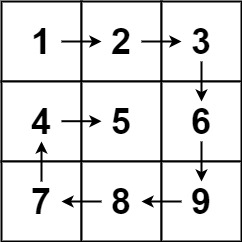给你一个 m 行 n 列的矩阵 matrix ,请按照 顺时针螺旋顺序 ,返回矩阵中的所有元素。
示例 1:

1
2
| 输入:matrix = [[1,2,3],[4,5,6],[7,8,9]]
输出:[1,2,3,6,9,8,7,4,5]
|
示例 2:

1
2
| 输入:matrix = [[1,2,3,4],[5,6,7,8],[9,10,11,12]]
输出:[1,2,3,4,8,12,11,10,9,5,6,7]
|
提示:
m == matrix.lengthn == matrix[i].length1 <= m, n <= 10-100 <= matrix[i][j] <= 100
题目大意
给定一个 m 行 n 列的矩阵,按顺时针螺旋顺序返回矩阵中的所有元素。
解题思路
采用方向向量结合边界判断的方法:
- 定义四个方向(右、下、左、上)的坐标变化
- 遍历矩阵元素,按当前方向移动
- 当遇到边界或已访问元素时,顺时针切换方向
- 直到收集完所有元素
1
2
3
4
5
6
7
8
9
10
11
12
13
14
15
16
17
18
19
20
21
22
23
24
25
26
27
28
29
30
31
32
33
34
35
36
37
38
39
40
41
42
43
| class Solution {
public:
vector<int> spiralOrder(vector<vector<int>>& matrix) {
vector<int> result;
if (matrix.empty()) {
return result;
}
int m = matrix.size();
int n = matrix[0].size();
// 标记是否访问过
vector<vector<bool>> visited(m, vector<bool>(n, false));
// 方向向量:右、下、左、上
vector<pair<int, int>> dirs = {{0, 1}, {1, 0}, {0, -1}, {-1, 0}};
int dir = 0; // 当前方向索引
int row = 0, col = 0;
for (int i = 0; i < m * n; ++i) {
// 记录当前元素
result.push_back(matrix[row][col]);
visited[row][col] = true;
// 计算下一个位置
int next_row = row + dirs[dir].first;
int next_col = col + dirs[dir].second;
// 判断是否需要改变方向
if (next_row < 0 || next_row >= m ||
next_col < 0 || next_col >= n ||
visited[next_row][next_col]) {
dir = (dir + 1) % 4; // 顺时针转向
next_row = row + dirs[dir].first;
next_col = col + dirs[dir].second;
}
// 更新当前位置
row = next_row;
col = next_col;
}
return result;
}
};
|



